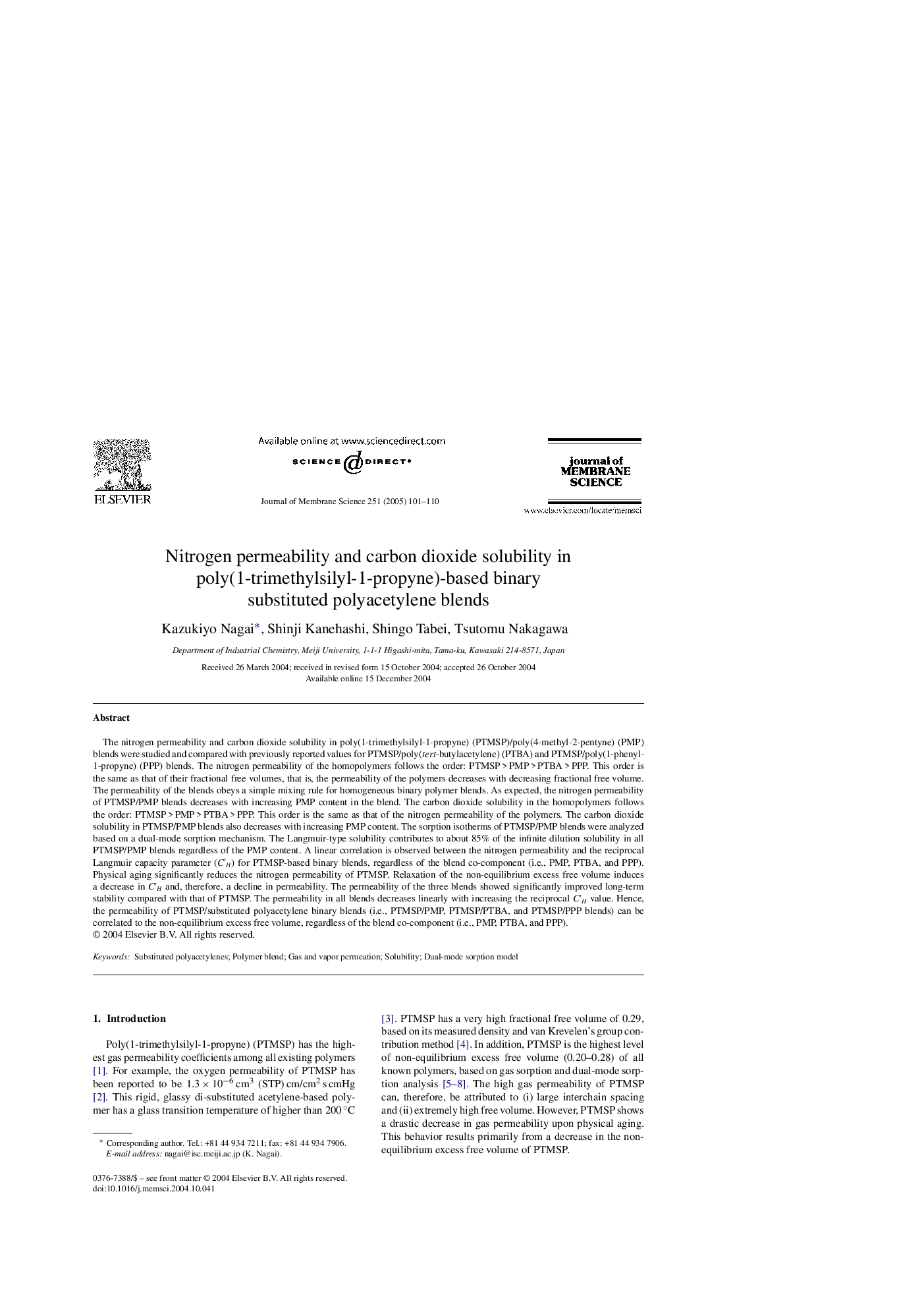| کد مقاله | کد نشریه | سال انتشار | مقاله انگلیسی | نسخه تمام متن |
|---|---|---|---|---|
| 9684971 | 1456219 | 2005 | 10 صفحه PDF | دانلود رایگان |
عنوان انگلیسی مقاله ISI
Nitrogen permeability and carbon dioxide solubility in poly(1-trimethylsilyl-1-propyne)-based binary substituted polyacetylene blends
دانلود مقاله + سفارش ترجمه
دانلود مقاله ISI انگلیسی
رایگان برای ایرانیان
کلمات کلیدی
موضوعات مرتبط
مهندسی و علوم پایه
مهندسی شیمی
تصفیه و جداسازی
پیش نمایش صفحه اول مقاله

چکیده انگلیسی
The nitrogen permeability and carbon dioxide solubility in poly(1-trimethylsilyl-1-propyne) (PTMSP)/poly(4-methyl-2-pentyne) (PMP) blends were studied and compared with previously reported values for PTMSP/poly(tert-butylacetylene) (PTBA) and PTMSP/poly(1-phenyl-1-propyne) (PPP) blends. The nitrogen permeability of the homopolymers follows the order: PTMSPÂ >Â PMPÂ >Â PTBAÂ >Â PPP. This order is the same as that of their fractional free volumes, that is, the permeability of the polymers decreases with decreasing fractional free volume. The permeability of the blends obeys a simple mixing rule for homogeneous binary polymer blends. As expected, the nitrogen permeability of PTMSP/PMP blends decreases with increasing PMP content in the blend. The carbon dioxide solubility in the homopolymers follows the order: PTMSPÂ >Â PMPÂ >Â PTBAÂ >Â PPP. This order is the same as that of the nitrogen permeability of the polymers. The carbon dioxide solubility in PTMSP/PMP blends also decreases with increasing PMP content. The sorption isotherms of PTMSP/PMP blends were analyzed based on a dual-mode sorption mechanism. The Langmuir-type solubility contributes to about 85% of the infinite dilution solubility in all PTMSP/PMP blends regardless of the PMP content. A linear correlation is observed between the nitrogen permeability and the reciprocal Langmuir capacity parameter (Câ²H) for PTMSP-based binary blends, regardless of the blend co-component (i.e., PMP, PTBA, and PPP). Physical aging significantly reduces the nitrogen permeability of PTMSP. Relaxation of the non-equilibrium excess free volume induces a decrease in Câ²H and, therefore, a decline in permeability. The permeability of the three blends showed significantly improved long-term stability compared with that of PTMSP. The permeability in all blends decreases linearly with increasing the reciprocal Câ²H value. Hence, the permeability of PTMSP/substituted polyacetylene binary blends (i.e., PTMSP/PMP, PTMSP/PTBA, and PTMSP/PPP blends) can be correlated to the non-equilibrium excess free volume, regardless of the blend co-component (i.e., PMP, PTBA, and PPP).
ناشر
Database: Elsevier - ScienceDirect (ساینس دایرکت)
Journal: Journal of Membrane Science - Volume 251, Issues 1â2, 1 April 2005, Pages 101-110
Journal: Journal of Membrane Science - Volume 251, Issues 1â2, 1 April 2005, Pages 101-110
نویسندگان
Kazukiyo Nagai, Shinji Kanehashi, Shingo Tabei, Tsutomu Nakagawa,